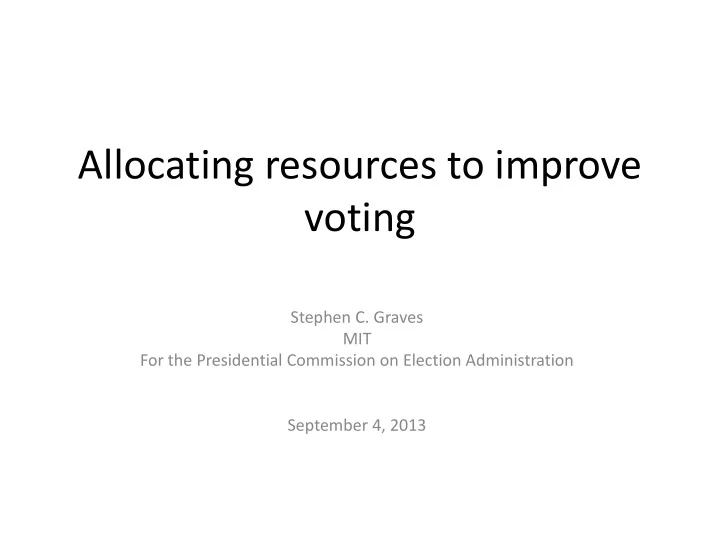

Allocating resources to improve voting Stephen C. Graves MIT For the Presidential Commission on Election Administration September 4, 2013
• Long lines occur when resources are inadequate • Yet resources are inevitably constrained • Managers must decide how best to allocate resources to get best overall performance • Tools exist to help managers understand the trade-offs and make these decisions
– How best to allocate a given number of machines or staff across a set of precincts? – How many machines (staff) are needed in each precinct to achieve a waiting time service target? – What if’s? How do the answers depend on various estimates and assumptions?
Queuing Theory
Voting as a queuing system
• Demonstrate capabilities of a simple spreadsheet tool • Relies on “text - book” queuing models • Could be incorporated into an optimization or search algorithm • Should be coupled with simulation tool that can validate, examine more carefully impact of daily dynamics, and help with detailed planning
Screen Shot of Resource Allocation Tool Inputs in Yellow Managerial Parameters X = max-wait-time target registration service Outputs in pink (seconds) time (seconds) 180 20 Target percent for Y = service level 90% no registration wait 80% wait time reduction from one more number of people number of voting System Percent wait time greater # of machines req'd to machine (seconds needed to assure precincts peak arrival rate average time to vote stations/machines Stability? average waiting time than X meet service level per voter) no/modest waits (voters per hour) (minutes per voter) (seconds per voter) 1 100 10 22 OK 17.42 3% 20.33 7.88 1.44 2 150 10 28 OK 91.46 19% 29.04 40.30 1.79 3 200 10 35 OK 250.74 42% 37.65 126.57 2.11 4 75 10 22 OK 0.66 0% 15.89 0.35 1.25 5 80 10 22 OK 1.42 0% 16.79 0.73 1.29 6 120 10 22 OK 170.37 31% 23.83 87.23 1.58 7 220 10 38 OK 342.30 51% 41.08 184.95 2.23 8 120 10 22 OK 170.37 31% 23.83 87.23 1.58 9 180 10 35 OK 34.15 6% 34.22 12.96 1.98 10 90 10 22 OK 5.43 1% 18.56 2.58 1.37 totals 268 16.62
Example • 3 precincts, 15 machines to allocate • Average time to vote = 6 minutes • Service target: max wait time of 3 minutes • Focus on peak period • Inputs: precinct arrival/hr 1 25 2 35 3 45
Suppose we allocate equally: ave wait time % wait more than 3 precinct arrival/hr machines (sec's) min's 1 25 5 19 4% 2 35 5 91 18% 3 45 5 549 59% Can we do better?
Can we improve the allocation? ave wait time % wait more than 3 precinct arrival/hr machines (sec's) min's 1 25 4 77 15% 2 35 5 91 18% 3 45 6 101 20% ave wait time % wait more than 3 precinct arrival/hr machines (sec's) min's 1 25 3 506 55% 2 35 5 91 18% 3 45 7 31 6% What if we have one more machine?
What’s the value from more resources? Reduction in precinct arrival/hr machines wait (sec's) 1 25 4 58 2 35 5 65 3 45 6 70 ave wait time % wait more than 3 Reduction in precinct arrival/hr machines (sec's) min's wait (sec's) 1 25 4 77 15% 58 2 35 5 91 18% 65 3 45 7 31 6% 21
Suppose we want at most 10% of voters to incur waits more than 3 minutes precinct arrival/hr required machines 1 25 5 2 35 6 3 45 7 ave wait time % wait more than 3 precinct arrival/hr machines (sec's) min's 1 25 5 19 4% 2 35 6 26 5% 3 45 7 31 6%
Suppose we re-design the ballot so that the time to vote is reduced from 6 to 5.4 minutes: % wait more than 3 precinct arrival/hr machines ave wait time (sec's) min's 1 25 4 45 9% 2 35 5 48 10% 3 45 6 49 10%
Check-In • Similar analyses apply here, e.g. – Suppose average check-in time = 0.5 minutes – How many stations are needed so that no more than 20% of voters experience a wait at check-in? precinct arrival/hr required stations 1 25 1 2 35 2 3 45 2 • Analysis accounts for (& can compare)design of check-in : single line or multiple lines?
Summary • Waiting occurs due to inadequate resources • This can occur due to insufficient system resources or due to poor allocation. • Tools based on queuing theory can provide guidance to improve resource allocation and to determine resource requirements • Tools require inputs: arrival rates; time to vote; and service targets • Tools should be deployed with tutorials and with capabilities for detailed simulations
Recommend
More recommend